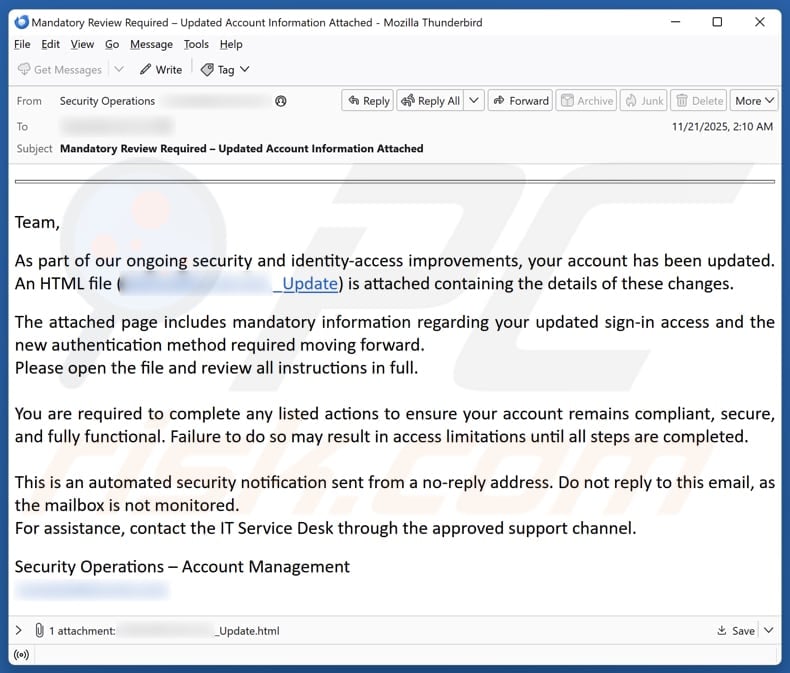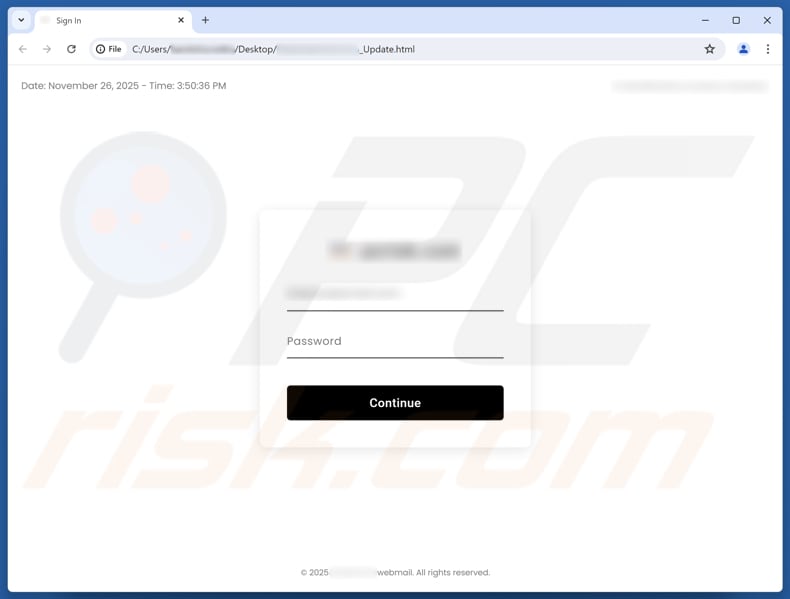How to spot scams like "Security And Identity-Access Improvements"
Phishing/ScamAlso Known As: Security And Identity-Access Improvements phishing email
Get free scan and check if your device is infected.
Remove it nowTo use full-featured product, you have to purchase a license for Combo Cleaner. Seven days free trial available. Combo Cleaner is owned and operated by RCS LT, the parent company of PCRisk.com.
What is "Security And Identity-Access Improvements"?
We have inspected the email and concluded that it is designed to trick recipients into revealing sensitive information through the attached file. It states that a review of the updated account information is mandatory to appear urgent. Falling for this scam can result in account compromise and other issues.

More about the "Security And Identity-Access Improvements" scam email
This scam email claims to come from a security or IT team. It claims that the recipient's account has been updated as part of security improvements. The message instructs the recipient to open an attached HTML file to review mandatory changes to sign-in access and a new authentication method.
It warns that failure to follow the instructions could result in restricted account access. The email instructs the recipient to complete the listed actions to maintain account compliance. Overall, the email is designed to appear legitimate to convince the recipient to open the attachment, which contains a fake login form.
The attached HTML file is used to steal the recipient's email address and password. These credentials can be used to take over accounts such as social media, banking, email, gaming, or other services. Scammers may use them to commit identity theft, carry out unauthorized transactions or purchases, spread malware, send phishing messages, and engage in other fraudulent activities.
For this reason, recognizing scam emails is crucial to protect accounts and avoid risks such as financial loss, identity theft, damage to reputation, and other potential consequences.
| Name | Security And Identity-Access Improvements Email Scam |
| Threat Type | Phishing, Scam, Social Engineering, Fraud |
| Fake Claim | The recipient's account has been updated |
| Disguise | Message from the security or IT service desk |
| Detection Names (Attachment) | AhnLab-V3 (HTML/Phishing.S24), Combo Cleaner (JS:Trojan.Cryxos.15335), Ikarus (Phishing.HTML.Doc), Microsoft (Trojan:Script/Wacatac.B!ml), Varist (JS/Phish.BYW), Full List Of Detections (VirusTotal) |
| Symptoms | Unauthorized online purchases, changed online account passwords, identity theft, illegal access of the computer. |
| Distribution methods | Deceptive emails, rogue online pop-up ads, search engine poisoning techniques, misspelled domains. |
| Damage | Loss of sensitive private information, monetary loss, identity theft. |
| Malware Removal (Windows) |
To eliminate possible malware infections, scan your computer with legitimate antivirus software. Our security researchers recommend using Combo Cleaner. Download Combo CleanerTo use full-featured product, you have to purchase a license for Combo Cleaner. 7 days free trial available. Combo Cleaner is owned and operated by RCS LT, the parent company of PCRisk.com. |
Conclusion
This scam email is created to trick the recipient into opening a malicious attachment. The attachment is designed to steal login credentials. Stolen credentials can be used to hijack accounts. Being able to recognize such emails helps protect against potential negative outcomes.
Some examples of similar scams are "Document Review Request", "Document Ready For Review", and "Request To Close Your Mail Server". It is important to note that sometimes emails of this kind can be used to distribute malware.
How do spam campaigns infect computers?
Computers can become infected through email when users open malicious attachments that contain hidden malware. Files attached to such emails are often malicious documents, executables, script files, archives, or other types of files. Malware can be launched after opening a file or taking additional actions, such as enabling macros in infected documents.
Clicking on harmful links can also lead to fake websites that automatically download malicious software or use deceptive methods to trick users into downloading it themselves.
How to avoid installation of malware?
Keep your operating system, browser, and other software up to date. Use reputable antivirus or anti-malware tools and run scans regularly. Avoid opening unexpected attachments or links in suspicious emails or other types of messages. Do not interact with ads, pop-ups, and other elements on dubious pages.
Also, do not permit shady websites to send you notifications and avoid downloading pirated software, cracking tools, or key generators.
Text presented in the "Security And Identity-Access Improvements" email letter:
Subject: Mandatory Review Required – Updated Account Information Attached
Team,
As part of our ongoing security and identity-access improvements, your account has been updated. An HTML file (********_Update) is attached containing the details of these changes.
The attached page includes mandatory information regarding your updated sign-in access and the new authentication method required moving forward.
Please open the file and review all instructions in full.You are required to complete any listed actions to ensure your account remains compliant, secure, and fully functional. Failure to do so may result in access limitations until all steps are completed.
This is an automated security notification sent from a no-reply address. Do not reply to this email, as the mailbox is not monitored.
For assistance, contact the IT Service Desk through the approved support channel.Security Operations – Account Management
********
Fake login form presented within the attached file:

Instant automatic malware removal:
Manual threat removal might be a lengthy and complicated process that requires advanced IT skills. Combo Cleaner is a professional automatic malware removal tool that is recommended to get rid of malware. Download it by clicking the button below:
DOWNLOAD Combo CleanerBy downloading any software listed on this website you agree to our Privacy Policy and Terms of Use. To use full-featured product, you have to purchase a license for Combo Cleaner. 7 days free trial available. Combo Cleaner is owned and operated by RCS LT, the parent company of PCRisk.com.
Quick menu:
- What is Security And Identity-Access Improvements phishing email?
- Types of malicious emails.
- How to spot a malicious email?
- What to do if you fell for an email scam?
Types of malicious emails:
![]() Phishing Emails
Phishing Emails
Most commonly, cybercriminals use deceptive emails to trick Internet users into giving away their sensitive private information, for example, login information for various online services, email accounts, or online banking information.
Such attacks are called phishing. In a phishing attack, cybercriminals usually send an email message with some popular service logo (for example, Microsoft, DHL, Amazon, Netflix), create urgency (wrong shipping address, expired password, etc.), and place a link which they hope their potential victims will click on.
After clicking the link presented in such email message, victims are redirected to a fake website that looks identical or extremely similar to the original one. Victims are then asked to enter their password, credit card details, or some other information that gets stolen by cybercriminals.
![]() Emails with Malicious Attachments
Emails with Malicious Attachments
Another popular attack vector is email spam with malicious attachments that infect users' computers with malware. Malicious attachments usually carry trojans that are capable of stealing passwords, banking information, and other sensitive information.
In such attacks, cybercriminals' main goal is to trick their potential victims into opening an infected email attachment. To achieve this goal, email messages usually talk about recently received invoices, faxes, or voice messages.
If a potential victim falls for the lure and opens the attachment, their computers get infected, and cybercriminals can collect a lot of sensitive information.
While it's a more complicated method to steal personal information (spam filters and antivirus programs usually detect such attempts), if successful, cybercriminals can get a much wider array of data and can collect information for a long period of time.
![]() Sextortion Emails
Sextortion Emails
This is a type of phishing. In this case, users receive an email claiming that a cybercriminal could access the webcam of the potential victim and has a video recording of one's masturbation.
To get rid of the video, victims are asked to pay a ransom (usually using Bitcoin or another cryptocurrency). Nevertheless, all of these claims are false - users who receive such emails should ignore and delete them.
How to spot a malicious email?
While cyber criminals try to make their lure emails look trustworthy, here are some things that you should look for when trying to spot a phishing email:
- Check the sender's ("from") email address: Hover your mouse over the "from" address and check if it's legitimate. For example, if you received an email from Microsoft, be sure to check if the email address is @microsoft.com and not something suspicious like @m1crosoft.com, @microsfot.com, @account-security-noreply.com, etc.
- Check for generic greetings: If the greeting in the email is "Dear user", "Dear @youremail.com", "Dear valued customer", this should raise suspiciousness. Most commonly, companies call you by your name. Lack of this information could signal a phishing attempt.
- Check the links in the email: Hover your mouse over the link presented in the email, if the link that appears seems suspicious, don't click it. For example, if you received an email from Microsoft and the link in the email shows that it will go to firebasestorage.googleapis.com/v0... you shouldn't trust it. It's best not to click any links in the emails but to visit the company website that sent you the email in the first place.
- Don't blindly trust email attachments: Most commonly, legitimate companies will ask you to log in to their website and to view any documents there; if you received an email with an attachment, it's a good idea to scan it with an antivirus application. Infected email attachments are a common attack vector used by cybercriminals.
To minimise the risk of opening phishing and malicious emails we recommend using Combo Cleaner Antivirus for Windows.
Example of a spam email:

What to do if you fell for an email scam?
- If you clicked on a link in a phishing email and entered your password - be sure to change your password as soon as possible. Usually, cybercriminals collect stolen credentials and then sell them to other groups that use them for malicious purposes. If you change your password in a timely manner, there's a chance that criminals won't have enough time to do any damage.
- If you entered your credit card information - contact your bank as soon as possible and explain the situation. There's a good chance that you will need to cancel your compromised credit card and get a new one.
- If you see any signs of identity theft - you should immediately contact the Federal Trade Commission. This institution will collect information about your situation and create a personal recovery plan.
- If you opened a malicious attachment - your computer is probably infected, you should scan it with a reputable antivirus application. For this purpose, we recommend using Combo Cleaner Antivirus for Windows.
- Help other Internet users - report phishing emails to Anti-Phishing Working Group, FBI’s Internet Crime Complaint Center, National Fraud Information Center and U.S. Department of Justice.
Frequently Asked Questions (FAQ)
Why did I receive this email?
Getting a scam email indicates that your email address has been collected by scammers. In most cases, these messages are sent in bulk and are not personally targeted.
I have provided my personal information when tricked by this email, what should I do?
If any login credentials were provided, immediately change all compromised passwords. If sensitive personal information, like credit card numbers or ID documents, was shared, promptly contact the appropriate bank, service, or authority.
I have downloaded and opened a malicious file attached to an email, is my computer infected?
Infected executable files can run malware immediately when opened. Documents like Word or Excel are usually safe but can become dangerous if features such as macros are enabled. The likelihood of infection varies depending on the file type.
I have read the email but did not open the attachment, is my computer infected?
A device becomes infected only when a harmful file is opened or a malicious link is clicked. Simply reading or viewing the message poses no risk.
Will Combo Cleaner remove malware infections that were present in email attachment?
Combo Cleaner can detect and remove most common malware, but running a full system scan is necessary to identify and eliminate more advanced or hidden threats.
Share:

Tomas Meskauskas
Expert security researcher, professional malware analyst
I am passionate about computer security and technology. I have an experience of over 10 years working in various companies related to computer technical issue solving and Internet security. I have been working as an author and editor for pcrisk.com since 2010. Follow me on Twitter and LinkedIn to stay informed about the latest online security threats.
PCrisk security portal is brought by a company RCS LT.
Joined forces of security researchers help educate computer users about the latest online security threats. More information about the company RCS LT.
Our malware removal guides are free. However, if you want to support us you can send us a donation.
DonatePCrisk security portal is brought by a company RCS LT.
Joined forces of security researchers help educate computer users about the latest online security threats. More information about the company RCS LT.
Our malware removal guides are free. However, if you want to support us you can send us a donation.
Donate
▼ Show Discussion